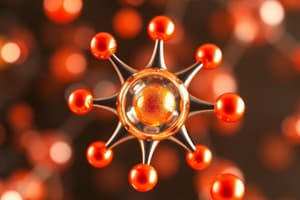Podcast
Questions and Answers
Which one of the following represents the first five ionization energies in kJ mol⁻¹ of an s-block element?
Which one of the following represents the first five ionization energies in kJ mol⁻¹ of an s-block element?
- 1000, 2300, 3400, 4600, 7000
- 580, 1800, 2700, 11600, 14800 (correct)
- 14800, 11600, 2700, 1800, 580
- 740, 1500, 7700, 10500, 13600
Isotopes are atoms which have the same ______ number but a different mass number (contain the same number of protons but a different number of neutrons).
Isotopes are atoms which have the same ______ number but a different mass number (contain the same number of protons but a different number of neutrons).
atomic
Electrons are arranged in energy levels, with the energy level n=1 being furthest from the nucleus.
Electrons are arranged in energy levels, with the energy level n=1 being furthest from the nucleus.
False (B)
What are the three fundamental subatomic particles that all atoms consist of?
What are the three fundamental subatomic particles that all atoms consist of?
What is the atomic number?
What is the atomic number?
What is the mass number?
What is the mass number?
What is the relative atomic mass (RAM)?
What is the relative atomic mass (RAM)?
What is an orbital?
What is an orbital?
What is first ionisation energy?
What is first ionisation energy?
Why does ionisation energy increase across a period?
Why does ionisation energy increase across a period?
Why does ionisation energy decrease down a group?
Why does ionisation energy decrease down a group?
Atoms of aluminum have a mass number of 27. How many neutrons are present in the nucleus of these atoms?
Atoms of aluminum have a mass number of 27. How many neutrons are present in the nucleus of these atoms?
Flashcards
Protons
Protons
Positively charged particles located in the nucleus.
Neutrons
Neutrons
Neutral particles located in the nucleus.
Electrons
Electrons
Negatively charged particles orbiting the nucleus in shells.
Atomic Number
Atomic Number
Signup and view all the flashcards
Mass Number
Mass Number
Signup and view all the flashcards
Isotopes
Isotopes
Signup and view all the flashcards
Relative Atomic Mass (RAM)
Relative Atomic Mass (RAM)
Signup and view all the flashcards
Relative Isotopic Mass (RIM)
Relative Isotopic Mass (RIM)
Signup and view all the flashcards
Relative Formula Mass (RFM)
Relative Formula Mass (RFM)
Signup and view all the flashcards
Relative Molecular Mass (RMM)
Relative Molecular Mass (RMM)
Signup and view all the flashcards
Mass Spectrometer
Mass Spectrometer
Signup and view all the flashcards
Mass-to-Charge Ratio (m/z)
Mass-to-Charge Ratio (m/z)
Signup and view all the flashcards
Electronic Configuration
Electronic Configuration
Signup and view all the flashcards
Orbital
Orbital
Signup and view all the flashcards
s orbital
s orbital
Signup and view all the flashcards
p orbital
p orbital
Signup and view all the flashcards
s-block element
s-block element
Signup and view all the flashcards
p-block element
p-block element
Signup and view all the flashcards
4s Subshell (in Transition Metals)
4s Subshell (in Transition Metals)
Signup and view all the flashcards
First Ionisation Energy
First Ionisation Energy
Signup and view all the flashcards
Second Ionisation Energy
Second Ionisation Energy
Signup and view all the flashcards
Ionisation Energy
Ionisation Energy
Signup and view all the flashcards
Atomic Radius Influence
Atomic Radius Influence
Signup and view all the flashcards
Shielding
Shielding
Signup and view all the flashcards
Nuclear Charge Influence
Nuclear Charge Influence
Signup and view all the flashcards
Ionisation Energy Trends
Ionisation Energy Trends
Signup and view all the flashcards
Aluminium's Lower IE
Aluminium's Lower IE
Signup and view all the flashcards
Sulfur's Lower IE
Sulfur's Lower IE
Signup and view all the flashcards
Successive IE Jumps
Successive IE Jumps
Signup and view all the flashcards
Isotopic Mass
Isotopic Mass
Signup and view all the flashcards
Study Notes
- Atoms consist of electrons, protons, and neutrons.
- Different elements have different numbers of these subatomic particles.
Atomic Number and Mass Number
- The atomic number is the number of protons in the nucleus of an atom and corresponds to the number of electrons in a neutral atom.
- The mass number is the total number of protons and neutrons in the nucleus of an atom.
Isotopes
- Isotopes are atoms with the same atomic number but different mass numbers, meaning they have the same number of protons but a different number of neutrons.
- A mass spectrometer is used to determine accurate atomic masses and relative abundances of isotopes.
- In a mass spectrometer, particles are turned into positive ions, accelerated, and deflected by an electromagnet.
- The path of ions depends on their mass-to-charge ratio (m/z).
- Mass spectrometry helps determine relative formula masses for identifying unknown compounds.
Calculating Relative Atomic Mass
- The relative atomic mass of an element is calculated using the weighted average of the masses of its isotopes.
- RAM = [(isotope 1 mass x % abundance) + (isotope 2 mass x % abundance) + ... ] / 100
Definitions
- Relative Atomic Mass (RAM) is the average mass of an atom of an element relative to one-twelfth of the mass of a carbon-12 atom.
- Relative Isotopic Mass (RIM) is the mass of an atom of an isotope relative to one-twelfth the mass of a carbon-12 atom.
- Relative Formula Mass (RFM) applies to ionic and giant covalent compounds and is the average mass of a formula unit relative to one-twelfth of carbon-12.
- Relative Molecular Mass (RMM) applies to molecular covalent substances and is the average mass of a molecule relative to one-twelfth of carbon-12.
Electronic Configuration
- Electrons are arranged in energy levels (shells), which consist of subshells that contain orbitals.
- An orbital, can hold up to two electrons with opposite spins.
- s orbitals are spherical, while p orbitals are dumbbell-shaped.
- Subshells can hold a specific number of electrons: s holds up to 2, p holds up to 6, d holds up to 10, and f holds up to 14.
Quantum Shells and Subshells
- n = 1 has one subshell (1s) and can hold 2 electrons.
- n = 2 has two subshells (2s, 2p) and can hold 8 electrons.
- n = 3 has three subshells (3s, 3p, 3d) and can hold 18 electrons.
- n = 4 has four subshells (4s, 4p, 4d, 4f) and can hold 32 electrons.
Filling Orbitals
- Electrons are placed in the lowest available energy levels first.
- Electrons are not paired in a subshell until each orbital in that subshell has one electron.
- When two electrons occupy the same orbital, they have opposite spins.
Blocks of the Periodic Table
- The periodic table is organized into blocks based on the subshell that contains the highest energy (outer) electron of an element.
- An s-block element has its highest energy electron in an s-subshell.
- A p-block element has its highest energy electron in a p-subshell.
- When writing electronic configurations for transition metal ions, electrons are removed from the 4s subshell before the 3d subshell.
Unusual Electronic Configurations
- Copper and chromium have electronic configurations that deviate from the expected pattern.
- Chromium's configuration is 1s² 2s² 2p⁶ 3s² 3p⁶ 3d⁵ 4s¹ (due to the stability of the half-filled 3d subshell).
- Copper's configuration is 1s² 2s² 2p⁶ 3s² 3p⁶ 3d¹⁰ 4s¹ (due to the stability of the full 3d subshell.)
Ionisation Energy
- Ionisation energy measures the energy needed to remove electrons from atoms.
- The greater the nuclear charge and the closer the electron is to the nucleus, the higher the ionisation energy.
- First ionisation energy is the energy required to remove one mole of electrons from one mole of gaseous atoms to form gaseous ions with a +1 charge.
- Successive ionisation energies refer to the removal of subsequent electrons.
Trends in Ionisation Energies
- Across a period, ionisation energy generally increases due to increasing nuclear charge and constant shielding.
- Down a group, ionisation energy generally decreases due to increasing atomic radius and shielding.
Successive Ionisation Energies
- Successive ionisation energies can indicate the group to which an element belongs.
- Large jumps in successive ionisation energies occur when an electron is removed from a new shell, indicating that the previous electrons were all in the same outer shell.
- For example, aluminium (1s² 2s² 2p⁶ 3s² 3p¹) has three relatively low ionisation energies followed by a large jump, indicating it's in Group 3.
- A dip in ionisation energy occurs with aluminium because its outer electron is in the 3p sub-shell, which is further from the nucleus than the 3s sub-shell in magnesium.
- Sulfur has a lower 1st ionisation energy than phosphorus because of the repulsion between paired electrons in the 3p orbital.
Studying That Suits You
Use AI to generate personalized quizzes and flashcards to suit your learning preferences.




